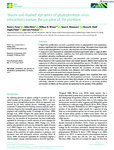“Boom‐and‐busted‐dynamics” of phytoplankton‐virus interactions explain the paradox of the plankton
| dc.contributor.author | Flynn, KJ | |
| dc.contributor.author | Mitra, A | |
| dc.contributor.author | Wilson, WH | |
| dc.contributor.author | Kimmance, SA | |
| dc.contributor.author | Clark, DR | |
| dc.contributor.author | Pelusi, A | |
| dc.contributor.author | Polimene, L | |
| dc.date.accessioned | 2022-03-11T14:22:28Z | |
| dc.date.available | 2022-03-11T14:22:28Z | |
| dc.date.issued | 2022-02-18 | |
| dc.identifier.issn | 0028-646X | |
| dc.identifier.issn | 1469-8137 | |
| dc.identifier.uri | http://hdl.handle.net/10026.1/18940 | |
| dc.description.abstract |
<jats:title>Summary</jats:title><jats:p> <jats:list list-type="bullet"> <jats:list-item><jats:p>Rapid virus proliferation can exert a powerful control on phytoplankton host populations, playing a significant role in marine biogeochemistry and ecology. We explore how marine lytic viruses impact phytoplankton succession, affecting host and nonhost populations.</jats:p></jats:list-item> <jats:list-item><jats:p>Using an <jats:italic>in silico</jats:italic> food web we conducted simulation experiments under a range of different abiotic and biotic conditions, exploring virus–host–grazer interactions and manipulating competition, allometry, motility and cyst cycles.</jats:p></jats:list-item> <jats:list-item><jats:p>Virus‐host and predator–prey interactions, and interactions with competitors, generate bloom dynamics with a pronounced ‘boom‐and‐busted’ dynamic (BBeD) which leads to the suppression of otherwise potentially successful phytoplankton species. The BBeD is less pronounced at low nutrient loading through distancing of phytoplankton hosts, while high sediment loading and high nonhost biomass decrease the abundance of viruses through adsorption. Larger hosts are inherently more distanced, but motility increases virus attack, while cyst cycles promote spatial and temporal distancing.</jats:p></jats:list-item> <jats:list-item><jats:p>Virus control of phytoplankton bloom development appears more important than virus‐induced termination of those blooms. This affects plankton succession – not only the growth of species infected by the virus, but also those that compete for the same resources and are collectively subjected to common grazer control. The role of viruses in structuring plankton communities via BBeDs can thus provide an explanation for the paradox of the plankton.</jats:p></jats:list-item> </jats:list> </jats:p> | |
| dc.format.extent | 990-1002 | |
| dc.format.medium | Print-Electronic | |
| dc.language | en | |
| dc.language.iso | en | |
| dc.publisher | Wiley | |
| dc.subject | competition | |
| dc.subject | cyst | |
| dc.subject | paradox of the plankton | |
| dc.subject | phytoplankton | |
| dc.subject | succession | |
| dc.subject | virus | |
| dc.subject | Ecology | |
| dc.subject | Ecosystem | |
| dc.subject | Food Chain | |
| dc.subject | Phytoplankton | |
| dc.subject | Plankton | |
| dc.subject | Viruses | |
| dc.title | “Boom‐and‐busted‐dynamics” of phytoplankton‐virus interactions explain the paradox of the plankton | |
| dc.type | journal-article | |
| dc.type | Journal Article | |
| dc.type | Research Support, Non-U.S. Gov't | |
| plymouth.author-url | https://www.ncbi.nlm.nih.gov/pubmed/35179778 | |
| plymouth.issue | 3 | |
| plymouth.volume | 234 | |
| plymouth.publication-status | Published | |
| plymouth.journal | New Phytologist | |
| dc.identifier.doi | 10.1111/nph.18042 | |
| plymouth.organisational-group | /Plymouth | |
| plymouth.organisational-group | /Plymouth/Faculty of Science and Engineering | |
| plymouth.organisational-group | /Plymouth/Faculty of Science and Engineering/School of Biological and Marine Sciences | |
| plymouth.organisational-group | /Plymouth/REF 2021 Researchers by UoA | |
| plymouth.organisational-group | /Plymouth/REF 2021 Researchers by UoA/UoA07 Earth Systems and Environmental Sciences | |
| plymouth.organisational-group | /Plymouth/Users by role | |
| plymouth.organisational-group | /Plymouth/Users by role/Academics | |
| dc.publisher.place | England | |
| dcterms.dateAccepted | 2022-02-04 | |
| dc.rights.embargodate | 2022-3-12 | |
| dc.identifier.eissn | 1469-8137 | |
| dc.rights.embargoperiod | Not known | |
| rioxxterms.versionofrecord | 10.1111/nph.18042 | |
| rioxxterms.licenseref.uri | http://www.rioxx.net/licenses/all-rights-reserved | |
| rioxxterms.licenseref.startdate | 2022-02-18 | |
| rioxxterms.type | Journal Article/Review |


